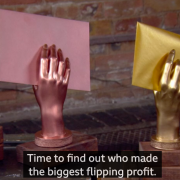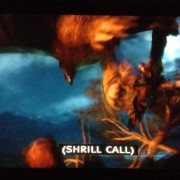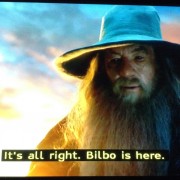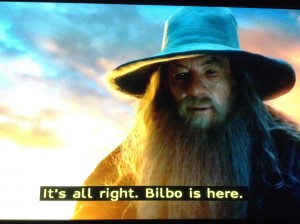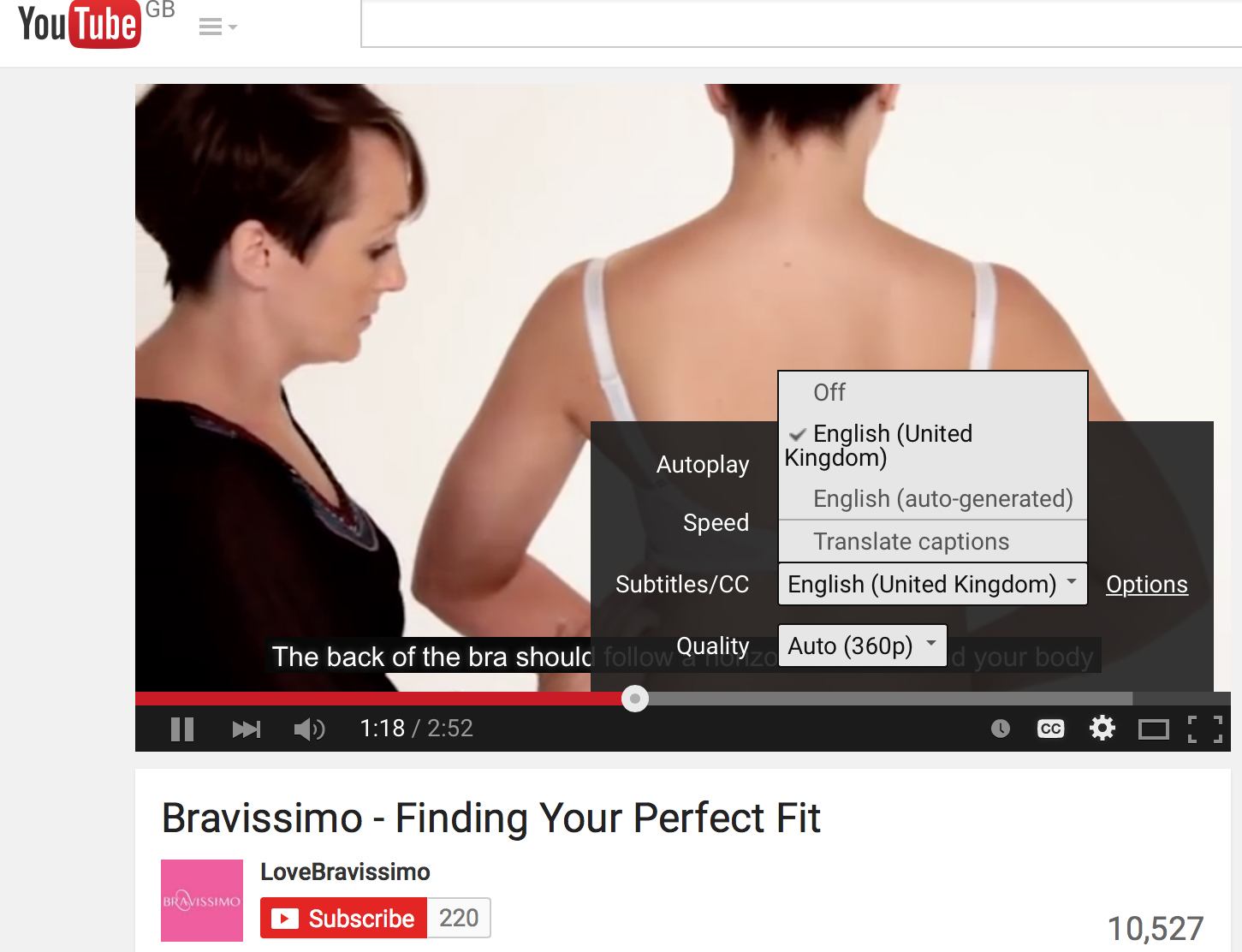Blog
The Secret to An Effective PowerPoint Presentation
/2 Comments/in Live captioning services /by Tina LanninClosed captioning improves YouTube viewing figures
/2 Comments/in Subtitles /by Tina LanninDid you know over 60 hours of video are uploaded to YouTube every minute? Wow.
How can you maximise the chances that your target audience will a) even find your video and b) watch it?
The answer: closed captioning.
A study by YouTube showed that videos with closed captioning get 4% more views than those without captions. Why is that? Because using closed captioning can improve how high up in search results Google places your video (that’s known as SEO).

Google can’t search the audio file of your videos. So, even if you have content on there that is relevant and useful to your target audience, Google won’t see it, and so won’t show it to your potential audience. That’s a real missed opportunity.
Using closed captioning can help Google find your video, recognise the keywords that describe the content, and then add it to the search results pages it produces when your potential customers ‘Google’ those keywords.
Closed captioning v auto-captioning from YouTube
YouTube does already provide an auto-captioning service that’s based on automatic speech recognition. But there are two good reasons not to use it:
1 – Because YouTube’s auto-captions are only 70% accurate, compared to close captioning’s 100% accuracy. After all the time and resources you have invested into creating a professional video, the last thing you want YouTube to do is create something incomprehensible and/or embarrassing like this:

2 – Because Google recognises that auto-captions are inaccurate and ignores them. Google and other search engines will only read files that have been uploaded to the video, like those provided through closed captioning.
Closed captioning for better rankings at home and abroad
Closed captioning isn’t just available in English. Our translation team can provide captions in over 80 different languages. That enables both international and non-native speakers to access your videos. And, just as with closed captioning in English, relevant search engines will read and index the captions. That can prove a big boost to your SEO, as there is less competition for keyword ranking in languages other than English.
Use transcripts to make your viewing figures even better
At the same time as sourcing closed captioning of your video it makes sense to create an accurate transcript of the film. Add it into the ‘description’ field for your video and you’ll help Google to find it, read it and show it to your potential customers.
To find out more about our subtitling services, contact us.
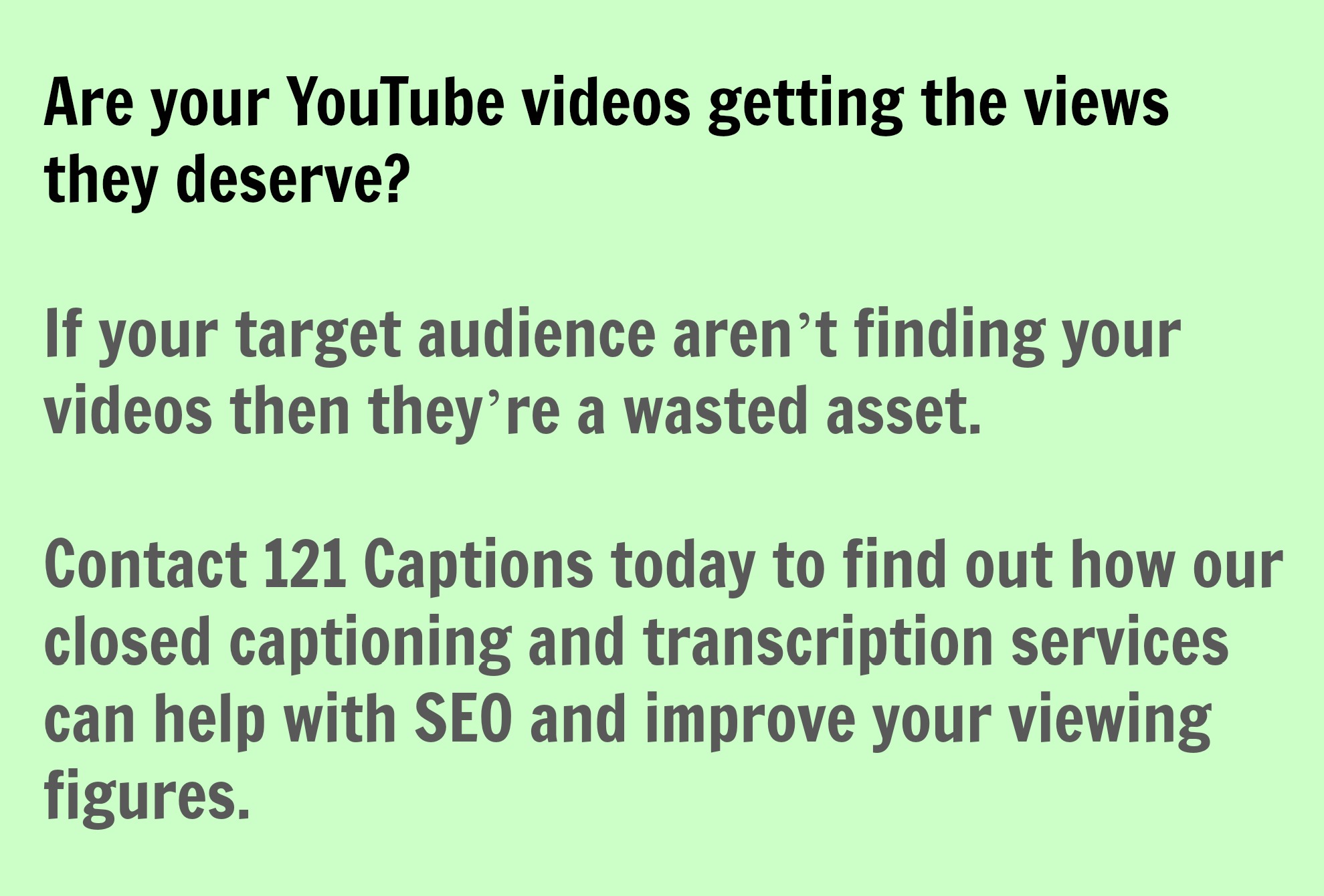
Offline captioning services
/0 Comments/in Subtitles /by Tina LanninOffline captioning services: An explanation.
It’s always been a conversation stopper over the past 20-odd years – “What do I do? I’m a subtitler.” Unless the person is in the professional broadcast or video business, people go away thinking I’m a foreign language translator or a sign language interpreter. I provide offline captioning services.
Multiply that confusion by a thousand, trying to persuade the public to make their online videos accessible. There’s a vague desire to have what is spoken turned into words on screen, but no idea how they would materialise in practice.
Closed captioning or creating subtitles is the process of adding text to a video, to make it accessible to deaf, hard of hearing, or non-native language viewers. Subtitles can be a direct translation of what is heard or a translation of the spoken language.
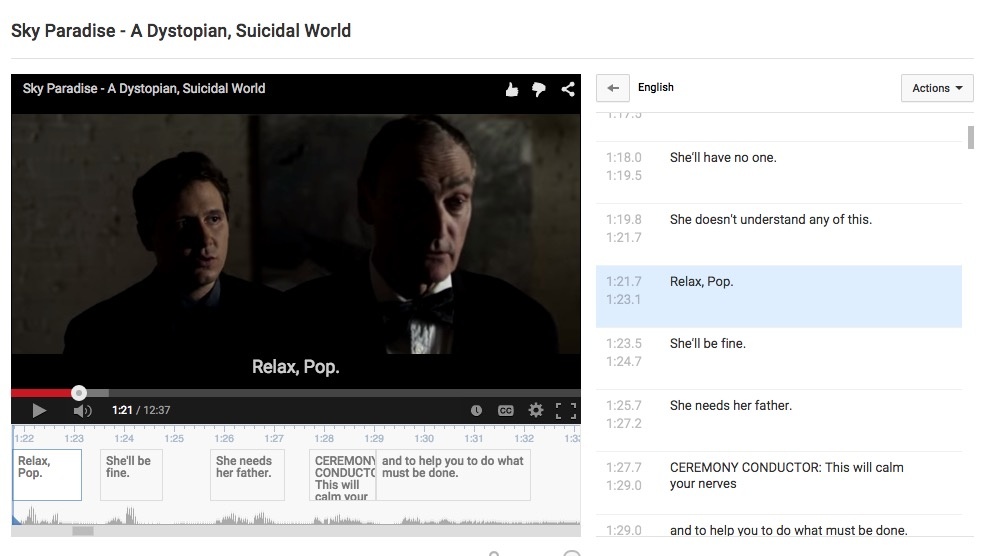
Creating the subtitles
The subtitles are carefully worked out by the subtitler so that:
- The words are in synch with the speech.
- Subtitles are on screen for enough time for the viewer to watch the subtitles as well as follow what’s going on visually.
- Split into easy-to-follow, grammatically cohesive subtitles.
- Line endings are, where possible, at natural points to aid reading.
- Placed at a point on screen not to obscure onscreen graphics or a speaker’s lips.
- Accents and tone of voice are sensitively represented.
- All names, places and registered trademarks are researched and accurate.
- The subtitles are often carefully timed to come in and out exactly with the shot changes and avoid a lot of short spaces between the subtitles, which lead to a “flashing” effect and can be tiring on the eyes.
Subtitling formats
When subtitling an online video, consider the following;
Access
How will the subtitled video be accessed by viewers? Will it be accessed via YouTube, Vimeo or other public online platforms? Will it be hosted on an organisation’s intranet? If so, will it be embedded from YouTube etc, or uploaded to the organisation’s own platform? Will you want to transfer the actual video file to specific people? Would you want to burn it to DVD?
There are upwards of 20 subtitle file formats currently in use, so it’s very important to let the subtitle provider know how you want the subtitled video to be accessed, so they can provide you with a compatible subtitle file format. Some platforms use formats where the coding for subtitle positioning or colours isn’t carried over.
Open or closed captions
Do you want subtitles that are there all the time or subtitles that are turned on and off? If you need a video file with permanent subtitles, it’s also possible, if working with mainstream amateur video editing / conversion software, to save costs by using the professional subtitle file to “burn” subtitles into your own video.
SEO (Search Engine Optimisation)
Would it be useful to make the entire spoken content of your online video searchable, rather than rely on keywords? By uploading a subtitle file to a YouTube video, the entire spoken content of the video is now “visible” to Google and other search engines, and each word or phrase is searchable. You don’t need to rely on keywords.
How much do offline captioning services cost?
Depending on what you decide, they all entail different offline captioning services and hence costs.
These range from supplying a professional format subtitle file with words and timecodes embedded (the quickest and cheapest way) to using the subtitle file to “burn in” the subtitles permanently to a copy of the video in post-production or video editing software. And if you need professional quality video with burnt-in subtitles, you may need a post-production video professional as well as a subtitler.
The most convenient and cost-effective way of providing you with a deaf-accessible video is to upload the video to YouTube along with a professional subtitle file to provide “closed caption” subtitles. This can be set to unlisted or private, if you want to choose who views the video. You can then just email the link and the viewer can choose to turn the subtitles on or off, if needed.
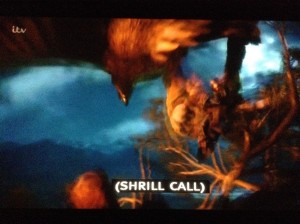
Subtitles for the deaf and hard of hearing (SDH)
Subtitles for the deaf and hard of hearing (SDH)
Definition
A subtitle file for the deaf and hard of hearing is a list of separate subtitles, each reflecting what is being said on the screen. Each subtitle is embedded with timecoded cues for when the subtitle begins and ends, corresponding to the video’s timecode.
How are SDH different from offline captioning services?
With subtitles for the deaf and hard of hearing, it is clear who’s speaking. This can be done with speakers being identified in different colours or the subtitles being placed appropriately on the screen.
All relevant non-spoken sounds are labelled with sound effects. For example, during a horror film, you might have the subtitle “suspenseful music” which gives additional information to the deaf viewer.
Send us your video for offline captioning services
Most video files are too large to be emailed, and need to be transferred to us via Dropbox, WeTransfer, or similar software. Alternatively, we can subtitle your YouTube video direct from your YouTube channel. We can advise you.
What we need to know before quoting for offline captioning services
Do you want a subtitle file to upload to the online video to provide closed captions? If so, what platform is being used and / or what format subtitle file do you require? We can subtitle any video format.
Do you want a video file with open captions (burnt-in subtitles)? What video format and what quality do you require? Can you use a subtitle file in conjunction with your own video editing software to burn the subtitles and make the job cheaper? If so, what format subtitle file is compatible?
When is your deadline? Do you require a 24 hour turnaround?
Does the video have a spoken English soundtrack? We sometimes get requests to add subtitles to videos which only have sign language and no audio track. We can translate and subtitle these videos for you. What languages do you require your subtitles to be in? We can subtitle your videos in over 80 languages.
Contact us for your closed captioning needs
The Hobbit: SDH subtitles for the deaf and hard of hearing
/0 Comments/in Subtitles /by Tina LanninWhat are SDH subtitles?
SDH subtitles are not always seen by TV viewers in the UK; we often get cheaper poor quality respeaking using Dragon voice recognition software. SDH subtitles were recently shown on a British TV channel’s The Hobbit: An Unexpected Journey – this was worth a viewing not just for the enhanced cinematography, but for the amazing quality of the subtitles themselves, causing a storm on social media. SDH subtitles are subtitles for the deaf and hard of hearing.
Subtitles for the deaf and hard of hearing are a transcription – they are subtitles in the same language as the spoken dialogue, with added information for those who cannot hear the environmental sounds or lyrics. Such subtitling gives fuller access to the film for deaf and hard of hearing viewers, those who cannot understand the spoken dialogue, or have problems understanding the accents.
The highest standards of SDH subtitles for the deaf and hard of hearing will have very close synchronisation of audio and subtitles, with the subtitles showing in different colours for different speakers. This film’s deaf viewers certainly got a wowser of an experience!
The production budget for this movie was $250,000,000 and to add subtitles would not have cost very much at all, less than 0.001% of the overall budget. We believe that subtitles (or closed captions) should be budgeted for from the very start for each movie, and should not be an afterthought or omission. Sir Peter Jackson, the film’s producer, has shown that it can be done.
Feedback from deaf and hard of hearing viewers
Well done Sir Peter Jackson. You did a sterling job for 360 million deaf and hard of hearing viewers around the world by ensuring your movie was subtitled properly. We very much enjoyed the subtitling experience and we want more of this! We are very pleased that ITV broadcasted the subtitle track as it was meant to be.
Ahhh – now we have an expert subtitler doing The Hobbit – on ITV – so much you miss at the cinema…. and via DVD – LOVING the add ons… I’m in heaven now. Different colours are working… grammatically correct, background noises are given.. who did this? Thought it was amazing – got so much more than I got from either the cinema or the DVD – that subtitler needs a medal for giving us access to “hidden noises” and umms and ahhs and screams…. it was like you were actually experiencing it in real life – finally! – Viewer
I’m watching it too.. Very good!! – Viewer
I did, really enjoyed it – subtitles were great. – Viewer
Were great x – Viewer
I enjoyed it alot.. it gave me all the sounds effects which sometimes gets missed out – Viewer
I tried watching it before without subtitles but had to give up. Tried again last night and finally got to enjoy it because of the subtitles. – Viewer
Brilliant subtitles – Viewer
I saw all three films at IMAX and for all its wondrous Hi-Fidelity I could hardly understand any of the dialogue – thankfully I read the books as a lad so knew what was going on mostly.
Had to buy the BluRay discs to get the subtitles to really enjoy it.
ITV deserve little praise for the subtitles for the Hobbit – they were supervised and coded by Peter Jackson himself – All ITV had to do was transmit them as provided on the film subtitle track.
What is apparent is how much we all enjoy programmes that meet these high standards.
We should call for this same high standard on EVERY pre-recorded content and work hard to get Live programming to match the best in class.
Automatic transcribing is not good enough – its lazy with a ‘We don’t care’ attitude – it’s all about the numbers we say we subtitle.
Not Good Enough broadcasters!
Could it be time for IBA to levy fines for under-performance? – Martyn Butler
Giving feedback on great SDH subtitling for deaf viewers
Do let this film’s producer Sir Peter Jackson and ITV know what you think of their SDH subtitles. It’s always nice to receive praise for a job done well. We loved these subtitles and we hope to see more of such outstanding quality.
- Director of The Hobbit: An Unexpected Journey – Sir Peter Jackson (Facebook page)
- viewerservices@itv.com
- Twitter @itvpresscentre @ITV
121 Captions SDH subtitles services
Subtitling for you in any video format, in over 80 languages, 24 hour turnaround
Find out more about SDH subtitles or contact us
Bravo Bravissimo for your subtitles!
/0 Comments/in Subtitles /by Tina Lannin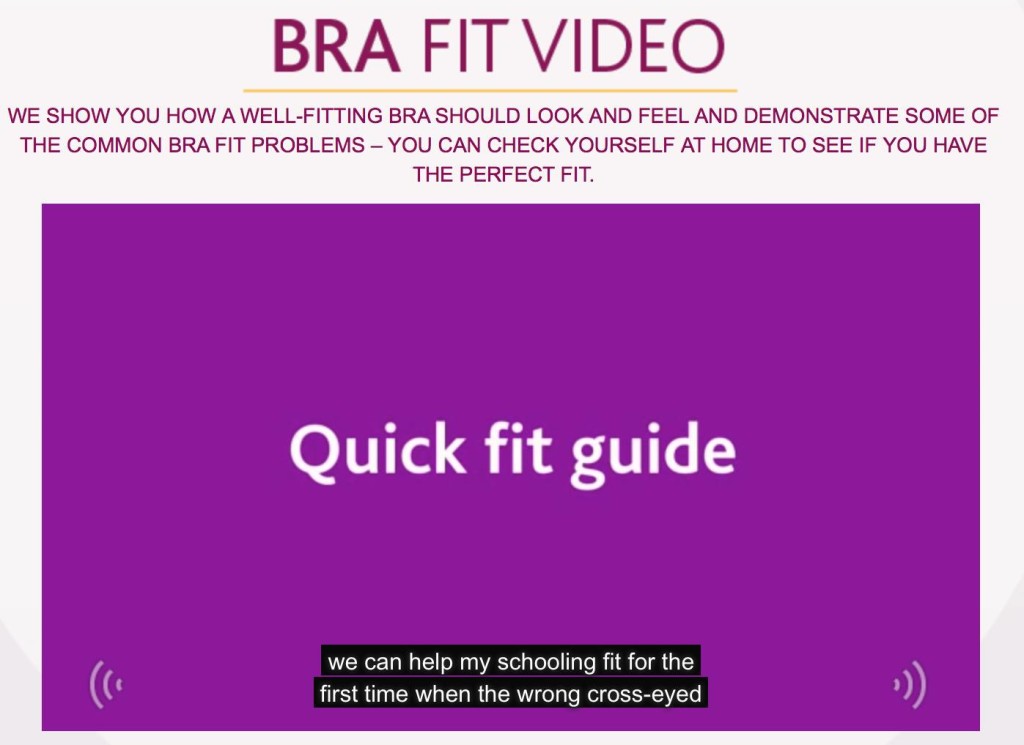
This auto captioning is definitely making us cross eyed
Where are the subtitles?
The ladies on the 121 Captions team are fans of Bravissimo, a British bra company. We were disappointed to discover their online video explaining how a bra should fit properly had poor subtitles.
When you upload a video to YouTube, and select the YouTube subtitling option, this generates automatic captions which are infamously poor and inaccurate. We had a good laugh at the errors and shared this with Bravissimo. We reminded them there are 360 million deaf people worldwide who would benefit from captioned videos, half of them being their potential customers.
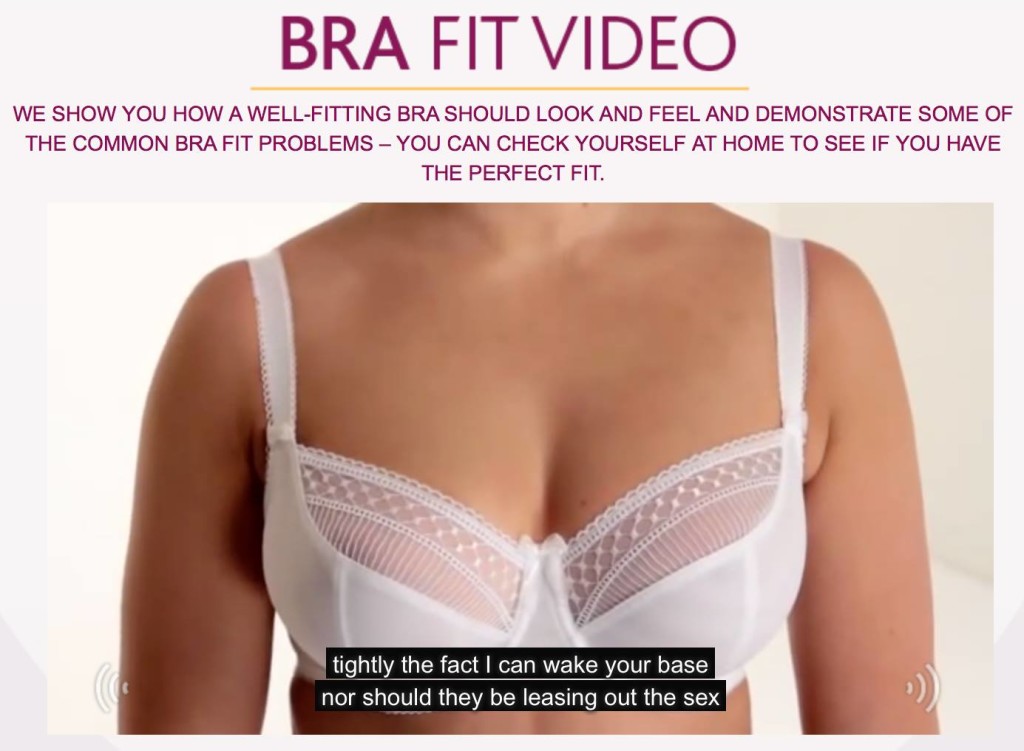
YouTube’s auto captioning on Bravissimo’s bra fit video
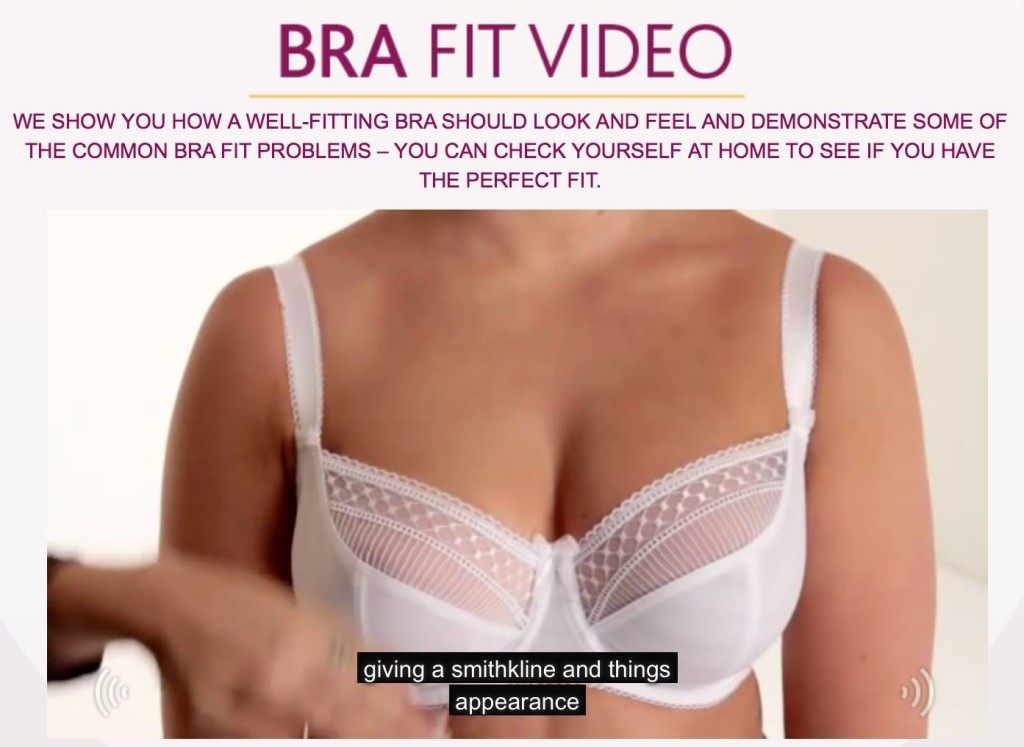
Sponsored by GlaxoSmithKline, perhaps?
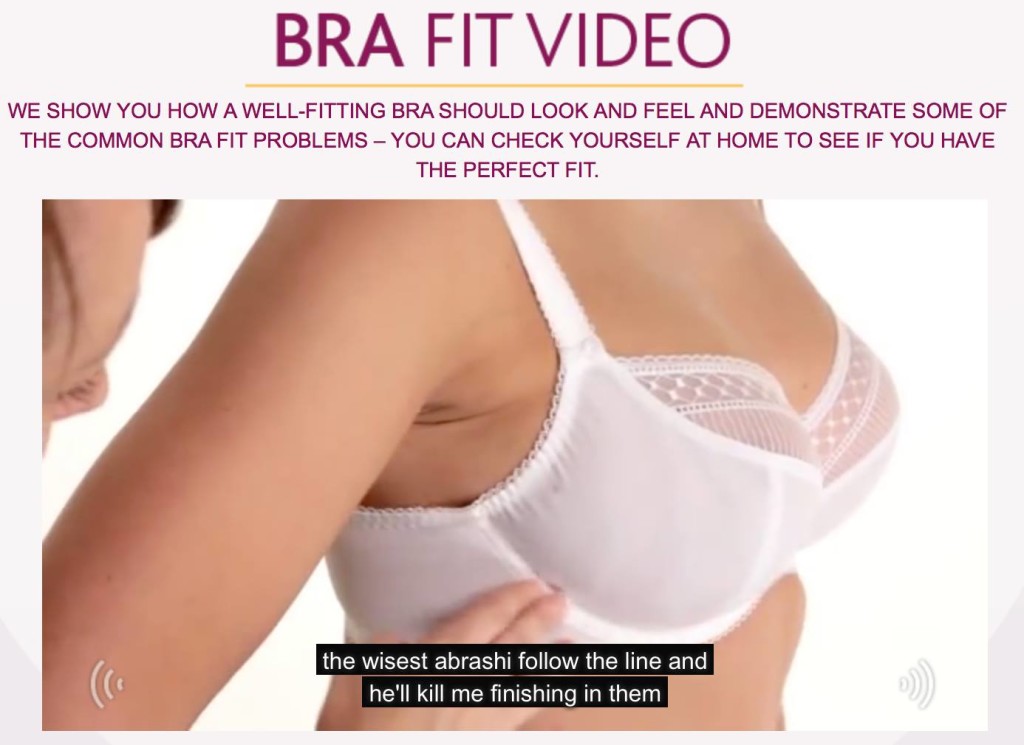
Oh Wise Abash is going to kill me!
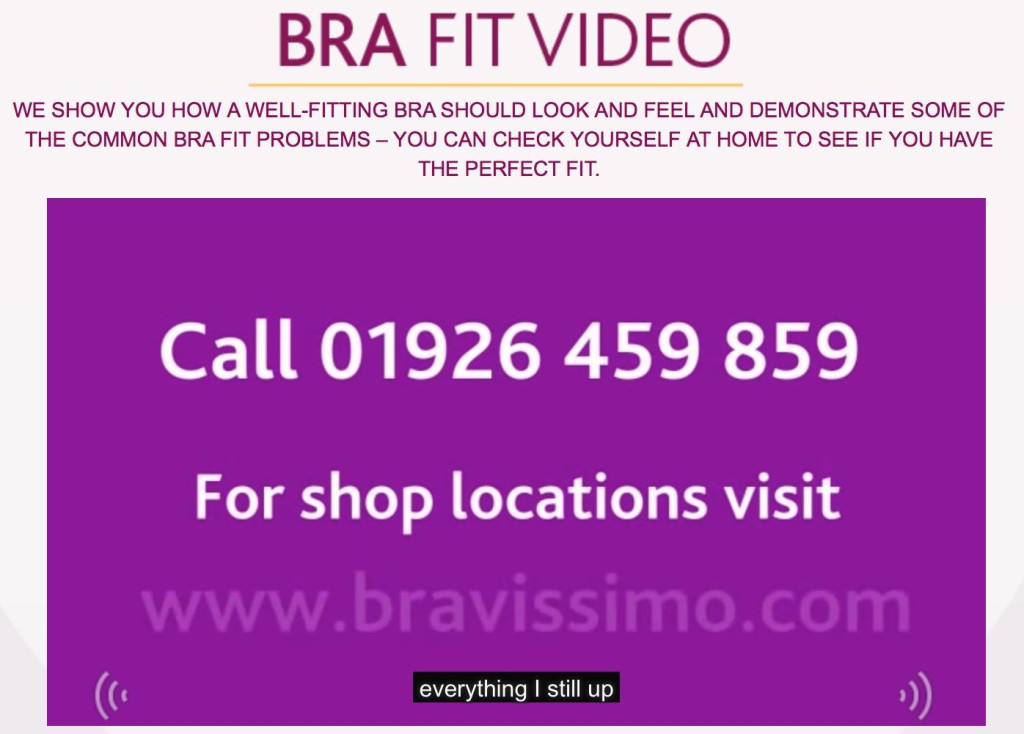
But everything is still staying up – bravo!!
What happened next?
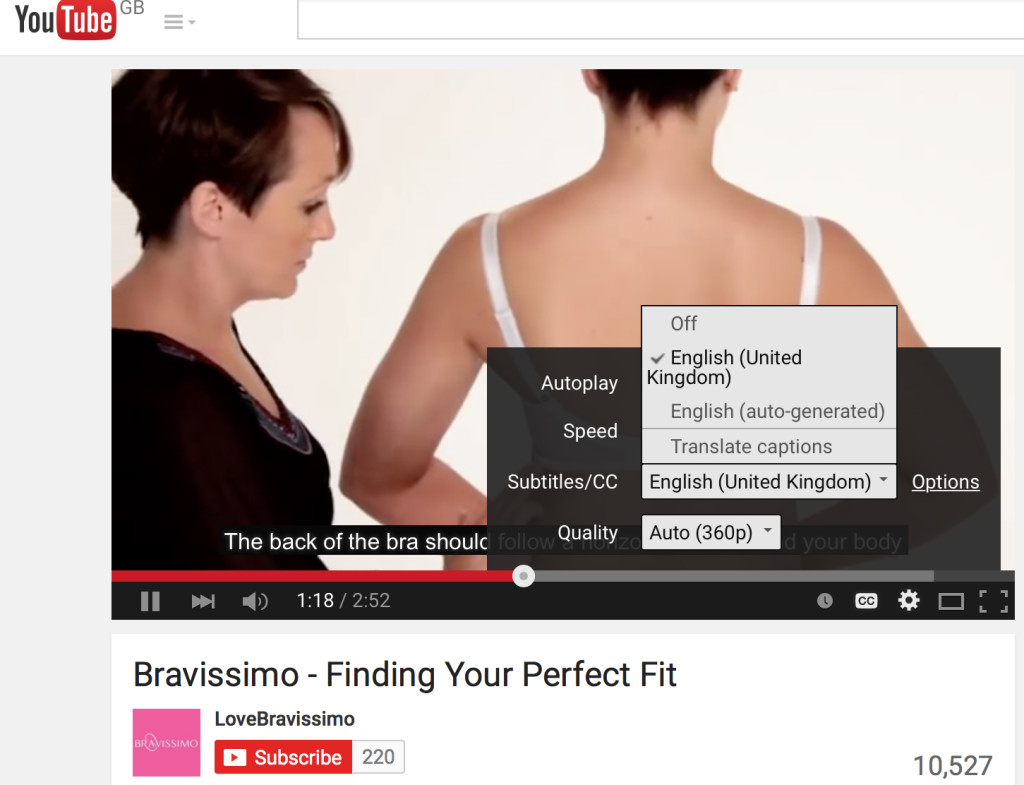
Selecting closed captions on YouTube
To their enormous credit, Bravissimo responded straight away. They apologised, investigated and reinstated the correct subtitles on the same day.
The new subtitles are correct and professionally edited. Well done, Bravissimo!
We wish all suppliers were so responsive and cared so much about their customer experience. They have certainly gained a lot more fans.
Now that Bravissimo’s video is correctly subtitled, their customer base should increase even more.
To view the professional closed captions, click the CC button then choose “English (United Kingdom)”.
If you choose “English (auto-generated)”, these are the poor automatic subtitles which all deaf viewers know and love!
Check out the re-subtitled Bravissimo bra fit video below with professional closed captions. Isn’t it fabulous?
Subtitles add value to your videos, not just access
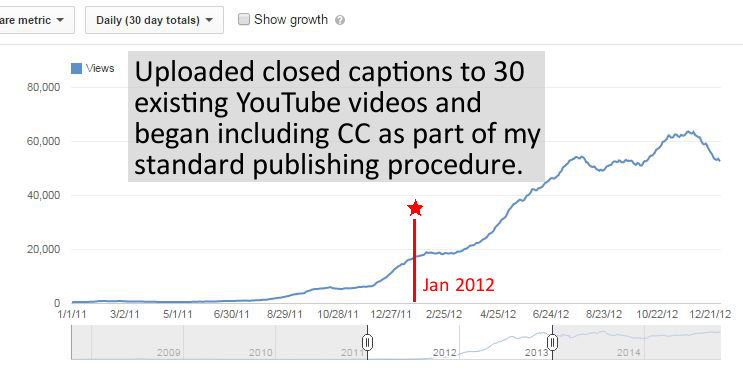
Did you know that adding professional captions to your YouTube videos will increase your channel views?
Check out this graph which outlines the value of adding captions.
You can add either closed captions (viewers can switch on and off) or open captions (permanently visible).
If you have videos on YouTube, Vimeo, or your staff intranet that need subtitles added, contact us about our professional video subtitling service on bookings@121captions.com
How subtitles are made for TV
/0 Comments/in Subtitles /by Tina Lannin
This video explains how subtitles or closed captions are made for TV.
Interview with Ofcom: Subtitles on television
/0 Comments/in Subtitles /by Tina LanninOfcom talk about subtitles on television
DURATION: 11:28
Are you interested in the quality of subtitles on television in the UK? See Hear speak to Peter Bourton of Ofcom about the regulation of subtitled and signed television in the UK, as well as a new consultation about signed television services.
To find out more about subtitles for your pre-recorded TV program or video, contact us at bookings@121captions.com
How smart subtitling technology could help deaf people
/0 Comments/in Live captioning services /by Tina LanninAuthor: William Mager | Original article: BBC News | Reproduced with kind permission of the author
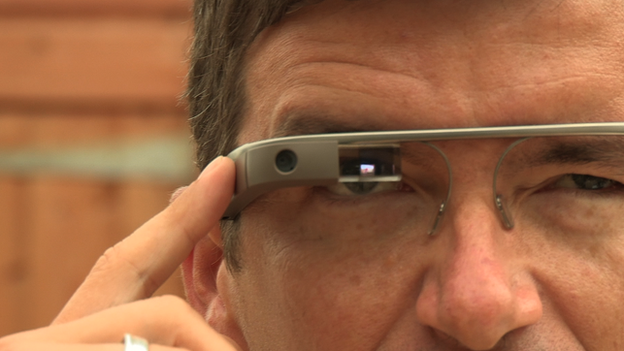
Subtitling & new technologies
There are many new technologies that can help people with disabilities, like live subtitling 24/7 for deaf people, but how well do they work?
Deaf people always remember the first time a new technology came on the scene, and made life just that little bit easier in a hearing world.
I’ve had many firsts. Television subtitles, text phones, the advent of the internet and texting all opened up opportunities for me to connect with the wider world and communicate more easily.
So when I first heard about Google Glass – wearable technology that positions a small computer screen above your right eye – I was excited. Live subtitling 24/7 and calling up an in-vision interpreter at the touch of a button. Remarkably both seemed possible.
That was a year ago. Since then, Tina Lannin of 121 Captions and Tim Scannell of Microlink have been working to make Google Glass for deaf people a reality. They agreed to let me test out their headset for the day.
First impressions
First impressions are that it feels quite light, but it is difficult to position so that the glass lens is directly in front of your eye.
Once you get it in the “sweet spot” you can see a small transparent screen, it feels as though it is positioned somewhere in the distance, and is in sharp focus. The moment you get the screen into that position feels like another first – another moment when the possibilities feel real.
But switching your focus from the screen to what’s going on around you can be a bit of a strain on the eyes. Looking “up” at the screen also makes me look like I’m a bad actor trying to show that I’ve had an idea, or that I’m deep in thought.
The menu system is accessed in two ways. There is a touch screen on the side which can be swiped back and forth, up and down, and you tap to select the option you want.
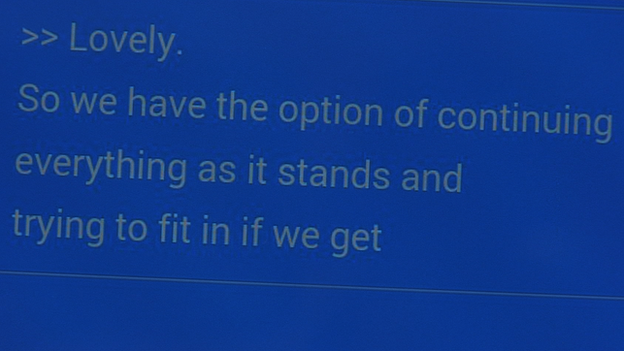
Google Glass can be used for live subtitling
Or you can control it by speaking, but this can be difficult if you’re deaf. Saying “OK Glass” to activate voice commands can be a bit hit and miss if your voice is not clear, like mine.
One of the main problems is the “wink to take a picture” setting. But I wink a lot. I also blink a lot. So I turn that setting off.
After a few minutes of reading online articles via Glass, it’s time to test out live remote captioning software in the real world. Lannin and Scannell’s service is called MiCap, a remote captioning service that works on several platforms – laptop, tablet, smartphone, e-book and Google Glass.
We set up in a quiet meeting room. After some fiddling with wi-fi and pairing various devices, we put a tablet in the middle of the table as our “listener”, and put the headset on. As three of my colleagues engage in a heated discussion about the schedule for programme 32 of See Hear, the remote captioner, listening somewhere in the cloud, begins to transcribe what they are hearing.
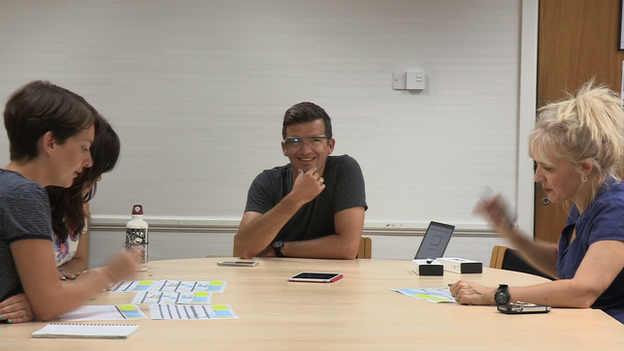
My first reaction is amazement. The captions scrolling across the screen in front of my eye are fast, word perfect, with a tiny time delay of one or two seconds. It is better than live subtitling seen on television, not to mention most palantypists who convert speech to text. I can follow everything that is being said in the room. Even more impressively, this is the first time that the app has been tested in a meeting. I can look around, listen a bit, and read the subtitles if I miss something.
But after a while, tiredness overtakes excitement, and I take the headset off.
See Hear is broadcast on BBC Two at 10:30 GMT on Wednesdays – or catch up on BBC iPlayer. The new series begins on 15 October 2014.
The headset itself is uncomfortable and fiddly, but despite this my first experience of Google Glass was enjoyable. It doesn’t offer anything that I can’t already do on my smartphone but the ability to look directly at someone at the same time as reading the subtitles, does make social interaction more “natural”.
Future developments
I am excited about the apps and software being developed by deaf-led companies in the UK. Not just remote captioning – also remote sign language interpreting. UK company SignVideo are already the first to offer live sign language interpreting via the Android and iOS platforms, and say that they’ll attempt a Google Glass equivalent in the future if demand is high enough.
Other companies such as Samsung and Microsoft are developing their own forms of smart glass and wearable technology and as the innovations reach the mainstream the range of applications which could help disabled people seems likely to grow.
There are lots of exciting tech firsts to come but I still prefer a more old-fashioned technology – the sign-language interpreter. They’re temperamental, and they might make mistakes too, but they’re fast, adaptable, portable – and they don’t need tech support when things go wrong.
Follow @BBCOuch on Twitter, and listen to our monthly talk show

